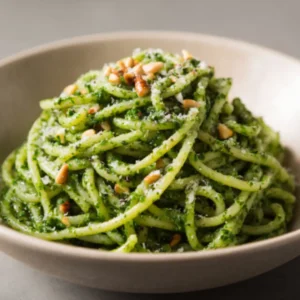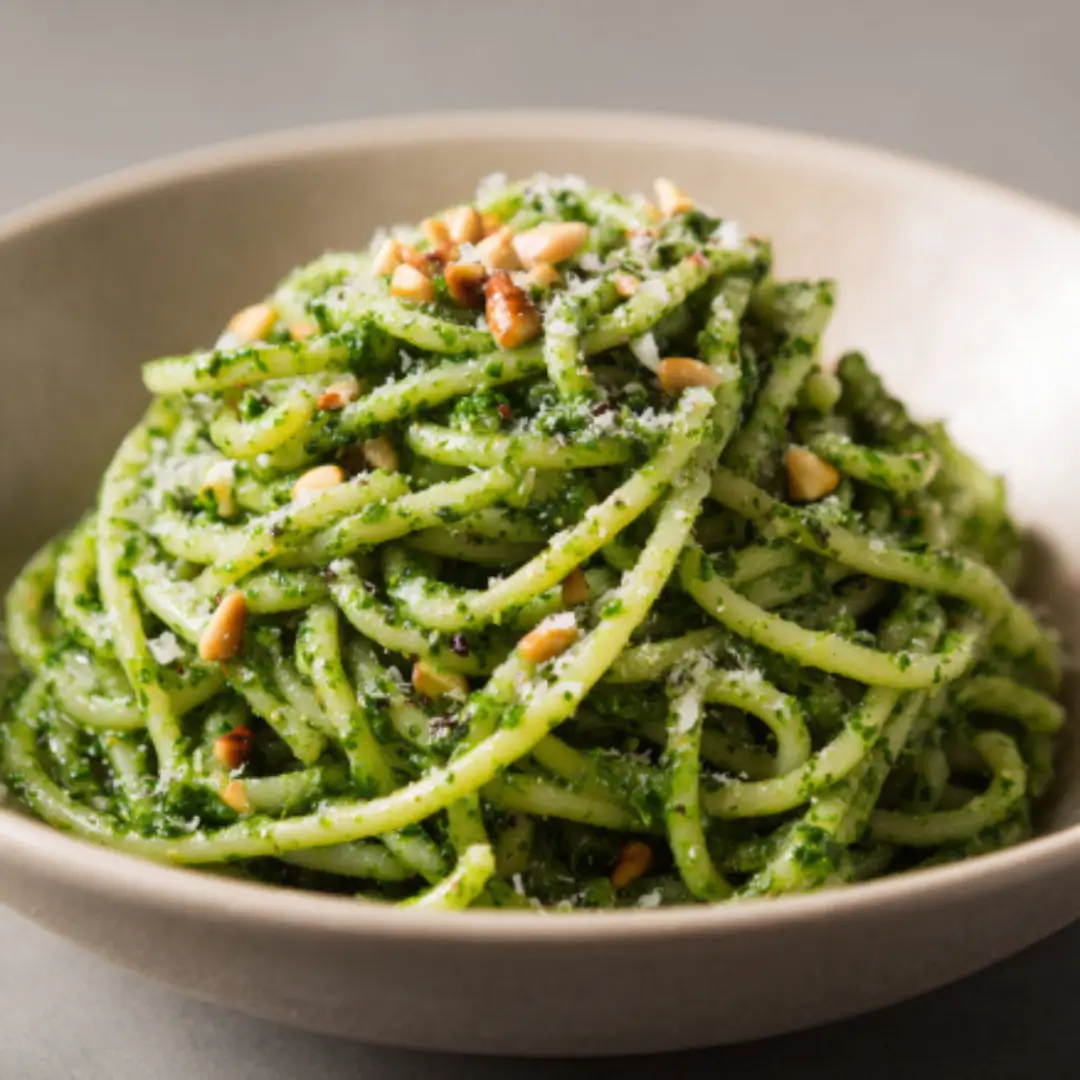Basil pesto pasta is an easy and tasty dish you can make at home. It uses fresh basil, garlic, pine nuts, Parmesan cheese, and olive oil to make a flavorful sauce. This sauce goes well with any pasta and takes just about 30 minutes to prepare. It’s a fresh, homemade alternative to store-bought sauces and perfect for a quick meal.
Why You’ll Love This Basil Pesto Pasta Recipe
There’s something magical about homemade basil pesto that sets it apart from anything store-bought. First, you control every ingredient, meaning you get the freshest basil and the purest olive oil. This results in a pesto bursting with vibrant green color and deep, fresh herbal notes. Plus, the texture is just right: creamy with a little crunch from toasted pine nuts and a subtle sharpness from Parmesan cheese. You’ll enjoy the quick prep time and the satisfaction of making a classic sauce from scratch. It pairs beautifully with many types of pasta, adding a sophisticated taste without complicated steps. This recipe is a perfect example of how simple ingredients can create a dish that feels both rustic and elegant.
Ingredients for Basil Pesto Pasta
To make your basil pesto pasta, you’ll need the following fresh ingredients:
- 2 1/2 cups fresh basil leaves, washed and dried thoroughly
- 2 tablespoons grated Parmesan cheese
- 3 cloves garlic, roughly chopped
- 2 tablespoons pine nuts, toasted and cooled
- 1/2 teaspoon kosher salt
- 1/8 teaspoon black pepper
- 1/4 cup extra virgin olive oil
How to Make Basil Pesto Pasta
Start by preparing your fresh basil leaves. It’s important they are well washed and completely dry to avoid any bitterness or watery sauce. Then gather all your ingredients: grated Parmesan cheese, roughly chopped garlic, toasted pine nuts, kosher salt, and black pepper.
Place the basil, Parmesan, garlic, pine nuts, salt, and pepper into a food processor or blender. Pulse the ingredients a few times until they start to combine. Next, while the processor is running on low speed, slowly drizzle in the extra virgin olive oil. This slow addition allows the oil to emulsify with the other ingredients, creating a smooth, creamy texture. If needed, scrape down the sides of the bowl to ensure everything is evenly blended.
Once the mixture forms a uniform sauce with a vibrant green color, taste your pesto. Adjust the seasoning by adding more salt or pepper if necessary. If you find the pesto too thick, you can add a bit more olive oil to loosen it slightly.
Your pesto is now ready to toss with your cooked pasta. Whether you use spaghetti, penne, or fusilli, add the pasta to a bowl, spoon on the pesto, and mix until every strand or piece is coated evenly. Serve immediately for the best taste.
If you’re not serving right away, transfer the pesto to an airtight container and store it in the refrigerator. To keep it fresh and prevent browning, pour a thin layer of olive oil over the surface before sealing.
How to Serve Basil Pesto Pasta
Serving basil pesto pasta is simple, but there are a few ways to elevate the experience. After tossing your pasta with the pesto, plate it neatly and consider topping it with extra freshly grated Parmesan cheese for a richer flavor. A sprinkle of toasted pine nuts on top adds texture and a beautiful touch.
For a little extra freshness, garnish with a few whole basil leaves or a small drizzle of high-quality olive oil. This can enhance the aroma and give the dish a glossy finish.
Basil pesto pasta pairs well with a variety of side dishes. A crisp green salad with lemon vinaigrette complements the herbaceous sauce perfectly. You can also serve crusty bread or garlic bread on the side to soak up any leftover pesto. For a heartier meal, add grilled vegetables or roasted chicken if you like.
Because basil pesto pasta is light but full of flavor, it’s great as a quick weekday meal or an easy dish to impress guests. Serve it warm and fresh for the best flavor experience.
Expert Tips for Perfect Basil Pesto Pasta
To make your basil pesto pasta truly outstanding, keep a few expert pointers in mind. First, always use fresh basil leaves that are free from bruises or dark spots. Freshness impacts both flavor and color. Washing and drying the leaves thoroughly is essential — any leftover water can dilute the pesto or cause it to spoil faster.
When toasting pine nuts, keep an eye on them to prevent burning. Use a dry skillet over medium-low heat and stir frequently until golden and fragrant. This step brings out the nuts’ natural oils and enhances their flavor, adding depth to your pesto.
Use good quality Parmesan cheese. Avoid pre-grated packets that may contain additives. Freshly grated Parmesan melts better into the sauce and provides a richer taste.
The olive oil you choose matters. Extra virgin olive oil with a fruity, mild flavor is best. Avoid overly bitter or peppery oils that can overpower the pesto.
If you want a creamier pesto, add a small spoonful of ricotta or a splash of pasta cooking water when tossing with pasta. The starch in the water helps the sauce stick and smooths the texture.
Finally, pesto is best eaten fresh but can be stored for a few days refrigerated. For longer storage, freeze it in ice cube trays for convenient single servings.
How to Store Basil Pesto Pasta
If you prepare basil pesto in advance or have leftovers, proper storage will help maintain its fresh flavor and color. Transfer the pesto to a clean, airtight container. To prevent discoloration, pour a thin layer of olive oil over the surface before sealing. This keeps air from reaching the sauce and stops oxidation.
Store the container in the refrigerator for up to 3-4 days. When ready to use, give it a good stir and add more olive oil if it looks thick or dry.
For longer storage, freezing is an excellent option. Spoon the pesto into ice cube trays and freeze. Once frozen, pop the cubes into a freezer-safe bag or container. This way, you can thaw small portions as needed, preserving the flavor and freshness without waste.
Avoid leaving pesto at room temperature for extended periods to prevent spoilage.
Variations of Basil Pesto Pasta
One of the great things about pesto is its flexibility. While traditional basil pesto is a classic, you can easily experiment with ingredients to match your taste or dietary needs.
Try swapping pine nuts for walnuts or almonds. These nuts offer a different flavor profile but still provide a nice texture and richness.
If you want a dairy-free or vegan version, omit the Parmesan cheese and replace it with nutritional yeast, which adds a cheesy flavor without dairy. You can also add a little lemon juice for brightness.
For a twist on the classic green, try making pesto with different herbs or greens like spinach, kale, or arugula. These variations can create new flavors and add nutritional benefits.
Adding fresh lemon zest or juice to your pesto can brighten the flavor and add a refreshing tang.
Finally, you can incorporate some chili flakes if you like a bit of heat or experiment with garlic amounts to suit your preference.
These variations keep the pesto exciting and customizable to your liking.
Frequently Asked Questions About Basil Pesto Pasta
What kind of basil is best for making pesto?
You should use fresh sweet basil leaves, which have a mild and aromatic flavor perfect for pesto. Avoid basil that is wilted or has dark spots.
Can I use other nuts instead of pine nuts?
Yes, walnuts, almonds, or cashews are good alternatives that will change the flavor slightly but still taste delicious.
How long can I store homemade pesto?
Stored in an airtight container with a layer of olive oil on top, pesto lasts about 3-4 days in the fridge. For longer storage, freezing is recommended.
Is it necessary to use Parmesan cheese?
Parmesan adds creaminess and saltiness, but you can substitute it with nutritional yeast for a dairy-free option.
Can I make pesto without a food processor?
Yes, you can finely chop the ingredients by hand and whisk in the olive oil, though it takes more time and effort.
What pasta works best with basil pesto?
Pasta shapes like spaghetti, linguine, fusilli, or penne work well because their shape holds the pesto nicely.

Basil Pesto Pasta
Equipment
- Food Processor
- Large Pot
Ingredients
- 2 1/2 cups fresh basil leaves (washed and dried thoroughly)
- 2 tablespoons grated Parmesan cheese
- 3 cloves garlic (roughly chopped)
- 2 tablespoons pine nuts (toasted and cooled)
- 1/2 teaspoon kosher salt
- 1/8 teaspoon black pepper
- 1/4 cup extra virgin olive oil
Instructions
- Prepare the basil leaves, ensuring they are well washed and completely dry.
- In a food processor, combine basil, Parmesan cheese, garlic, pine nuts, salt, and pepper. Pulse a few times until combined.
- With the processor running on low speed, slowly drizzle in the olive oil until the mixture is smooth and creamy.
- Taste the pesto and adjust seasoning as necessary. If too thick, add more olive oil to loosen.
- Toss the prepared pesto with cooked pasta until evenly coated. Serve immediately.
Send me this recipe!
Just enter your email below and get it sent straight to your inbox!



